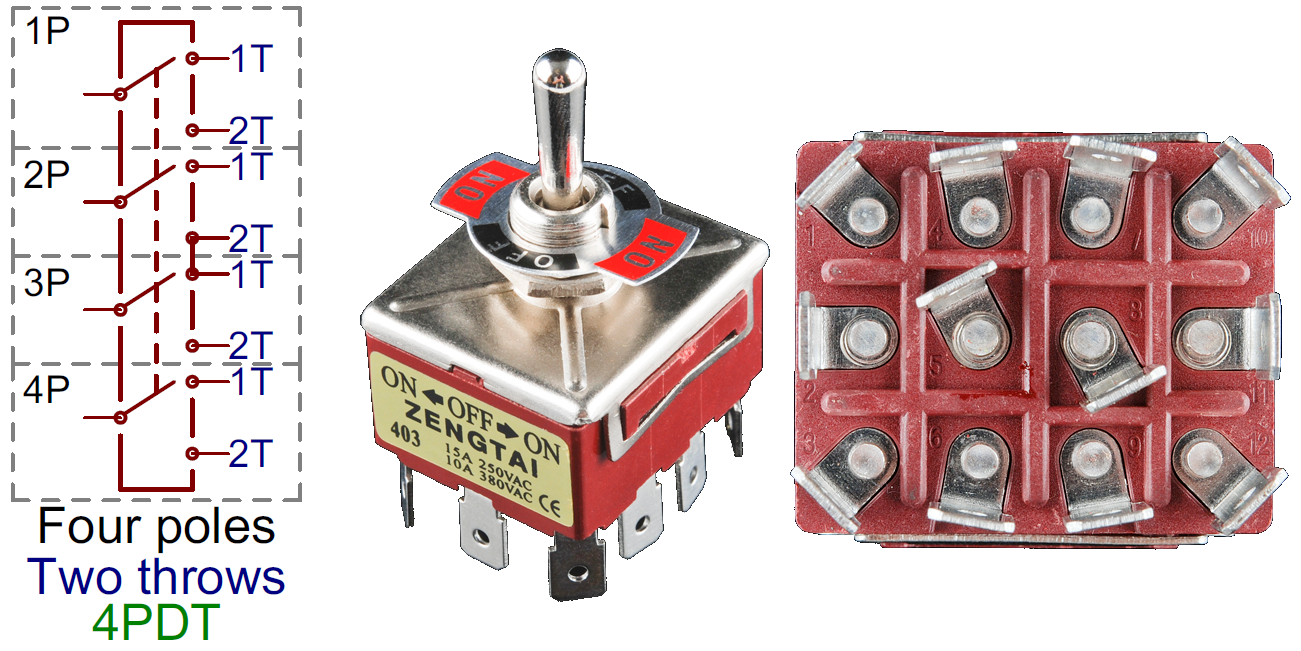How could it be a problem? because only one set of circuits is open at any one time using the DPDT switch. (Not related but the right channel's channels are labeled the wrong way round, I'll change it later.)
The shared ground problem occurs when left and right channels use the same ground. This means you can use a normal toddle switch to change between channels. This is a completely different circuit.
The shared ground problem occurs when left and right channels use the same ground. This means you can use a normal toddle switch to change between channels. This is a completely different circuit.
OK, I think I get it now. Some people do the switch by joining grounds on amp and speakers then using SPDT to just switch the grounds? It would never occur to me to do it that way as it leaves the 'unused' speakers still connected across the outputs so producing a channel difference signal in antiphase; simply wrong. To do it properly requires a DPDT switch (which is best put in the 'live' connector).
haha it took me a while of thinking about it to make this, so simple but confusing to get my head around. Could you explain why switching on the live connectors would be better? As far as my thinking went, as long as the circuit is broken it wouldn't matter at what point it is broken at.
Last edited:
That is what I suspected. Assume the switch is on ch 1. If you follow the circuit you can see that there is a path from L+in to R+in as follows:
L+in
L+ch2out
ch2 L speaker
L-ch2out
R-ch2out
ch2 R speaker
R+ch2out
R+in
So you have the ch2 speakers still connected across the outputs. They will receive a voltage equal to the difference between the two stereo channels. This will mainly be treble information, as bass tends to be the same on both channels - assuming genuine stereo and not just pan-potted pseudo-stereo. It might not be loud, but it will be there.
L+in
L+ch2out
ch2 L speaker
L-ch2out
R-ch2out
ch2 R speaker
R+ch2out
R+in
So you have the ch2 speakers still connected across the outputs. They will receive a voltage equal to the difference between the two stereo channels. This will mainly be treble information, as bass tends to be the same on both channels - assuming genuine stereo and not just pan-potted pseudo-stereo. It might not be loud, but it will be there.
Hi,
It doesn't fix anything, and certainly does not fix
"common ground" issues when they are an issue
by "commoning hot", that is simply just as wrong.
The only foolproof method is two DPDT switches.
It is no different to commoning ground, and at least
that will work with a common ground amplifier, whilst
the above won't work properly with any amplifier.
The common ground switching has the issue DF96
describes for amplifiers that are not common ground.
(As long as your clever enough to keep the grounds
entirely separate in the switching, otherwise you
will blow up a not common ground amplifier.)
rgds, sreten.
Simple loudspeaker switching for common ground, switch hot :
Does the same thing as a DPDT switch.
It doesn't fix anything, and certainly does not fix
"common ground" issues when they are an issue
by "commoning hot", that is simply just as wrong.
The only foolproof method is two DPDT switches.
It is no different to commoning ground, and at least
that will work with a common ground amplifier, whilst
the above won't work properly with any amplifier.
The common ground switching has the issue DF96
describes for amplifiers that are not common ground.
(As long as your clever enough to keep the grounds
entirely separate in the switching, otherwise you
will blow up a not common ground amplifier.)
rgds, sreten.
Simple loudspeaker switching for common ground, switch hot :
An externally hosted image should be here but it was not working when we last tested it.
Does the same thing as a DPDT switch.
Last edited:
Just to be clear, you want to switch between two pairs of speakers, driven by one amp?
4PDT 15A switch will toggle between both at the same time, if you want to control each separately, then 2 @ 2PDT as Sreten noted > I think you want the highest contact rating that physical space will allow, both to ensure life span, but to have room to solder your wires. (6 or 12 conductors per switch depending on above)
"Back in the day" we used such a set up to demonstrate "absolute phase", using two pairs of identical speakers side by side

4PDT 15A switch will toggle between both at the same time, if you want to control each separately, then 2 @ 2PDT as Sreten noted > I think you want the highest contact rating that physical space will allow, both to ensure life span, but to have room to solder your wires. (6 or 12 conductors per switch depending on above)
"Back in the day" we used such a set up to demonstrate "absolute phase", using two pairs of identical speakers side by side

Last edited:
"Back in the day" we used such a set up to
demonstrate "absolute phase", using two
pairs of identical speakers side by side.
Hi,
With that switch you don't need two pairs of speakers,
Standard common ground works for two pairs of speakers,
and doesn't care if one pair is out of phase to the other.
rgds, sreten.
At hifi speaker voltages you can triple or more
the current rating of a nominal 250VAC switch.
Last edited:
- Status
- This old topic is closed. If you want to reopen this topic, contact a moderator using the "Report Post" button.
- Home
- Design & Build
- Construction Tips
- Simple design for a speaker switch that avoids shared ground

